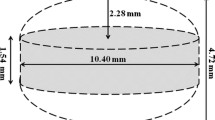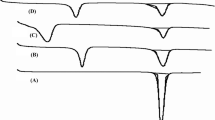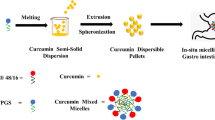Abstract
The objectives of this study were to develop and evaluate a novel self-emulsifying floating drug delivery system (SEFDDS) that resulted in improved solubility, dissolution, and controlled release of the poorly water-soluble tetrahydrocurcumin (THC). The formulations of liquid self-emulsifying drug delivery system (SEDDS; mixtures of Labrasol, Cremophor EL, Capryol 90, Labrafac PG) were optimized by solubility assay and pseudo-ternary phase diagram analysis. The liquid SEDDS was mixed with adsorbent (silicon dioxide), glyceryl behenate, pregelatinized starch, sodium starch glycolate, and microcrystalline cellulose and transformed into pellets by the extrusion/spheronization technique. The resulting pellets with 22% liquid SEDDS had a uniform size and good self-emulsification property. The microemulsions in aqueous media of different self-emulsifying floating pellet formulations were in a particle size range of 25.9–32.5 nm. Use of different weight proportions of glyceryl behenate and sodium starch glycolate in pellet formulations had different effects on the floating abilities and in vitro drug release. The optimum formulation (F2) had a floating efficiency of 93% at 6 h and provided a controlled release of THC over an 8-h period. The release rate and extent of release of THC liquid SEDDS (80% within 2 h) and self-emulsifying floating pellet formulation (80% within 8 h) were significantly higher than that of unformulated THC (only 30% within 8 h). The pellet formulation was stable under intermediate and accelerated storage conditions for up to 6 months. Controlled release from this novel SEFDDS can be a useful alternative for the strategic development of oral solid lipid-based formulations.










Similar content being viewed by others
References
Constantinides PP. Lipid microemulsions for improving drug dissolution and oral absorption: physical and biopharmaceutical aspects. Pharm Res. 1995;12:1561–72.
Charman SA, Charman WN, Rogge MC, Wilson TD, Dutko FJ, Pouton CW. Self-emulsifying drug delivery systems: formulation and biopharmaceutic evaluation of an investigational lipophilic compound. Pharm Res. 1992;9:87–93.
Shah NH, Carvajai MT, Patel CI, Infeld MH, Malick AW. Self-emulsifying drug delivery systems (SEDDS) with polyglycolyzed glycerides for improving in vitro dissolution and oral absorption of lipophilic drugs. Int J Pharm. 1994;106:15–23.
Tuleu C, Newton M, Rose J, Euler D, Saklatvala R, Clarke A, et al. Comparative bioavailability study in dogs of a self-emulsifiying formulation of progesterone presented in a pellet and a liquid form compared with an aqueous suspension of progesterone. J Pharm Sci. 2004;93:1495–502.
Serrtoni M, Newton M, Booth S, Clarke A. Controlled drug release from pellets containing water-insoluble drugs dissolved in a self-emulsifying system. Eur J Pharm Biopharm. 2007;65:94–8.
Desai S, Bolton S. A floating controlled-release drug delivery system: in vitro–in vivo evaluation. Pharm Res. 1993;10(9):1321–5.
Streubel A, Siepmann J, Bodmeier R. Floating matrix tablets based on low density: effects of formulation and processing parameters on drug release. Eur J Pharm Sci. 2003;18:37–45.
Elkheshen SA, Yassin AEB, Alsuwayeh S, Alkhaled FA. In vitro and in vivo evaluation of floating controlled release dosage forms of verapamil hydrochloride. Pharm Ind. 2004;66(11):1364–72.
Ruby AJ, Kuttan G, Babu KD, Rajasekharan KN, Kuttan R. Anti-tumor and antioxidant activity of natural curcuminnoids. Cancer Lett. 1995;94:79–83.
Gescher AJ, Sharma RA, Steward WP. Cancer chemoprevention by dietary constituents: a tale of failure and promise. Lancet Oncol. 2001;2:371–9.
Ireson CR, Jones DJL, Orr S, Coughtrie MWH, Boocock DJ, Williams ML, et al. Metabolism of the cancer chemopreventive agent curcumin in human and rat intestine. Cancer Epidemiol Biomark Prev. 2002;11:105–11.
Lukita AW, Ito Y, Baker GL, McCuskey RS. Effect of curcuminoids as anti-inflammatory agents on the hepatic microvascular response to endotoxin. Shock. 2002;17:399–403.
Chattopadhyay I, Bandyopadhyay U, Biswas K, Maity P, Banerjee RK. Indomethacin inactivates gastric peroxidase to induce reactive-oxygen-mediated gastric mucosal injury and curcumin protects it by preventing peroxidase inactivation and scavenging reactive oxygen. Free Radic Biol Med. 2006;40:1397–408.
Johnson JJ, Mukhtar H. Curcumin for chemopreventive of colon cancer. Cancer Lett. 2007;255:170–81.
Pan MH, Huang TM, Lin JK. Biotransformation of curcumin through reduction and glucuronidation in mice. Drug Metab Dispos. 1999;27:486–94.
Sugiyama Y, Kawakishi S, Osawa T. Involvement of the ß-diketone moiety in the antioxidant mechanism of tetrahydrocurcumin. Biochem Phamacol. 1996;52:519–25.
Sutanata W, Craig DQ, Newton JM. An evaluation of the mechanisms of drug release from glyceride bases. J Pharm Pharmacol. 1995;47:182–7.
Barthelemy P, Laforet JP, Farah N, Joachim J. Compritol 888 ATO: an innovative hot-melt coating agent for prolonged-release drug formations. Eur J Pharm Biopharm. 1999;47:87–90.
Faham A, Prinderre P, Piccerelle P, Farah N, Joachim J. Hot melt coating technology: influence of Compritol 888 Ato and granule size on chloroquine release. Pharmazie. 2000;55:444–8.
Mirghani A, Idkaidek NM, Salem MS, Najib NM. Formulation and release behavior of diclofenac sodium in Compritol 888 matrix beads encapsulated in alginate. Drug Dev Ind Pharm. 2000;26:791–5.
Abdalla A, Maeder K. Preparation and characterization of a self-emulsifying pellet formulation. Eur J Pharm Biopharm. 2007;66:220–6.
Hamdani J, Goole J, Moes AJ, Amighi K. In vitro and in vivo evaluation of floating riboflavin pellets developed using the melt pelletization process. Int J Pharm. 2006;323:86–92.
Narang AS, Delmarre D, Gaoc D. Stable drug encapsulation in micelles and microemulsions. Int J Pharm. 2007;345:9–25.
Spernath A, Aserin A, Garti N. Fully dilutable microemulsions embedded with phospholipids and stabilized by short-chain organic acids and polyols. J Colloid Interface Sci. 2006;299:900–9.
Wang Z, Sun J, Wang Y, Liu X, Liu Y, Fu Q, et al. Solid selfemulsifying nitrendipine pellets: preparation and in vitro/in vivo evaluation. Int J Pharm. 2010;383:1–6.
Podczeck F. A novel aid for the preparation of pellets by extrusion/spheronization. Pharm Tech Eur. 2008;20:26–31.
Li FQ, Hu JH, Deng JX, Su H, Xu S, Liu JY. In vitro controlled release of sodium ferulate from Compritol 888 ATO-based matrix tablets. Int J Pharm. 2006;324:152–7.
Iannuccelli V, Coppi G, Bernabei MT, Cameroni R. Air compartment multiple-unit system for prolonged gastric residence. Part I. Formulation study. Int J Pharm. 1998;174:47–54.
Costa P, Lobo JMS. Modeling and comparison of dissolution profiles. Eur J Pharm Sci. 2001;13:123–33.
Acknowledgments
Financial support was received from the Thailand Research Fund under the Royal Golden Jubilee Ph.D. program (PHD/0150/2549) and the Royal Thai Government through Prince of Songkla University. We also wish to thank Professor L.A. Damani and Dr. Brian Hobson for editing our manuscript.
Author information
Authors and Affiliations
Corresponding author
Rights and permissions
About this article
Cite this article
Setthacheewakul, S., Kedjinda, W., Maneenuan, D. et al. Controlled Release of Oral Tetrahydrocurcumin from a Novel Self-Emulsifying Floating Drug Delivery System (SEFDDS). AAPS PharmSciTech 12, 152–164 (2011). https://doi.org/10.1208/s12249-010-9568-8
Received:
Accepted:
Published:
Issue Date:
DOI: https://doi.org/10.1208/s12249-010-9568-8




